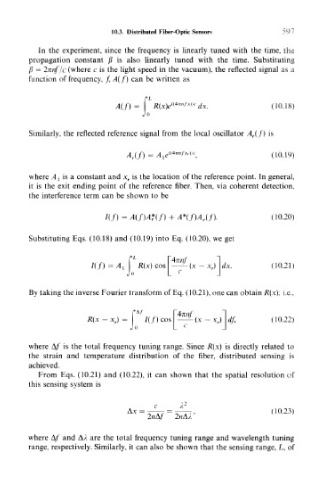Page 613 - Introduction to Information Optics
P. 613
10.3. Distributed Fiber-Optic Sensors 597
In the experiment, since the frequency is linearly tuned with the time, the
propagation constant /? is also linearly tuned with the time. Substituting
ft = 2nnf/c (where c is the light speed in the vacuum), the reflected signal as a
function of frequency, /, A(f) can be written as
fx c
i(
A(f) = R(x)e *™ » dx. (10.18)
Similarly, the reflected reference signal from the local oscillator A r(f) is
4
A r(f) = A^* *"^', (10.19)
where A lisa constant and x r is the location of the reference point. In general,
it is the exit ending point of the reference fiber. Then, via coherent detection,
the interference term can be shown to be
/(/) - A(f)A*(f) + A*(f)A,(f). ( 10.20)
Substituting Eqs. (10.18) and (10.19) into Eq. (10.20), we get
R(x) cos (10.21)
/(/) = A l
By taking the inverse Fourier transform of Eq. (10.21), one can obtain R(x); i.e.,
4nnf
R(x -~x r)= /(./) cos (x-x p ) df, (10.22)
where A/' is the total frequency tuning range. Since R(.x) is directly related to
the strain and temperature distribution of the fiber, distributed sensing is
achieved.
From Eqs. (10.21) and (10.22), it can shown that the spatial resolution of
this sensing system is
(la23
>
where A/ and A/I are the total frequency tuning range and wavelength tuning
range, respectively. Similarly, it can also be shown that the sensing range, L, of

